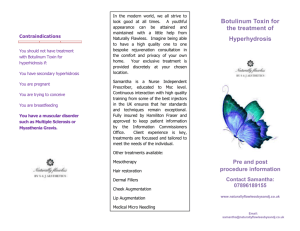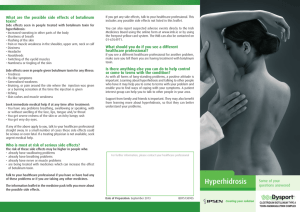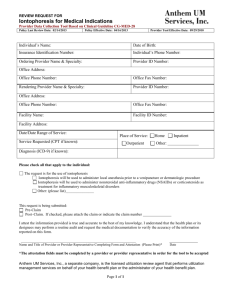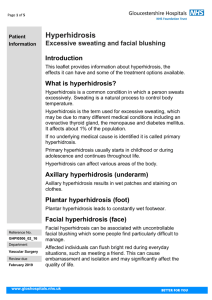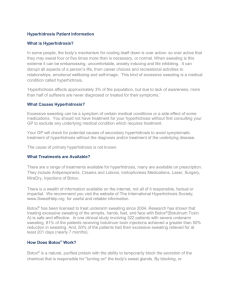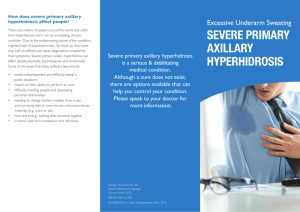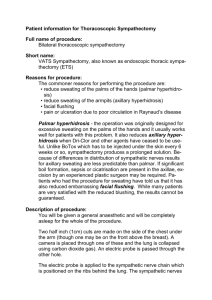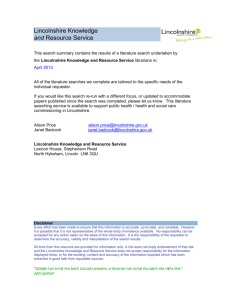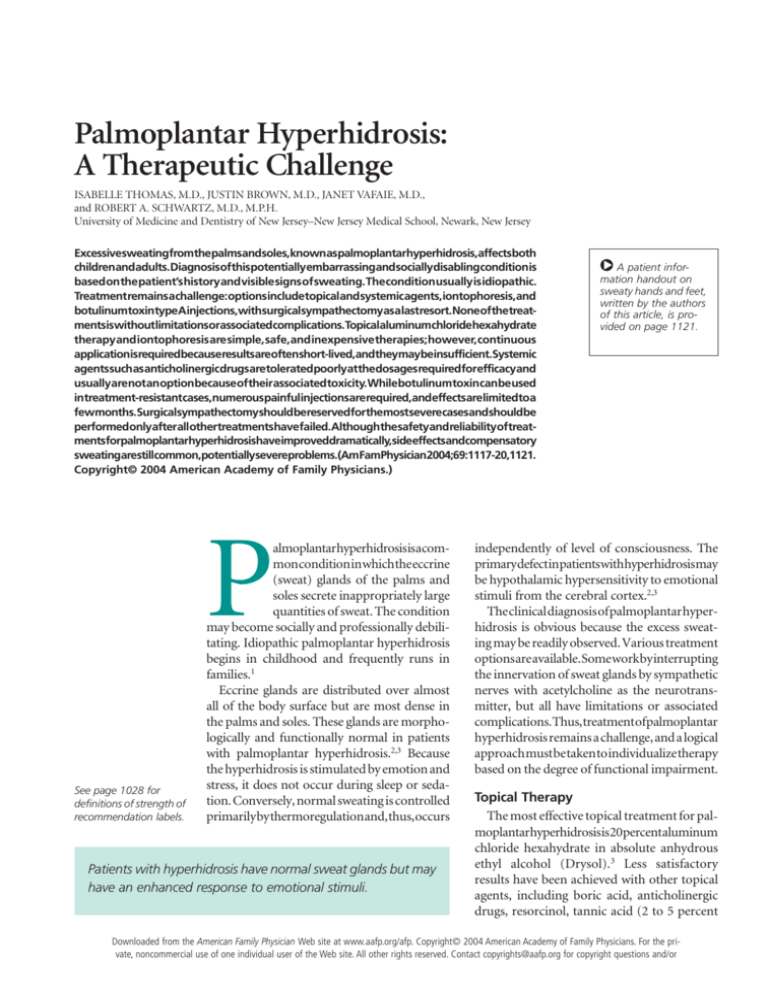
Palmoplantar Hyperhidrosis:
A Therapeutic Challenge
ISABELLE THOMAS, M.D., JUSTIN BROWN, M.D., JANET VAFAIE, M.D.,
and ROBERT A. SCHWARTZ, M.D., M.P.H.
University of Medicine and Dentistry of New Jersey–New Jersey Medical School, Newark, New Jersey
Excessivesweatingfromthepalmsandsoles,knownaspalmoplantarhyperhidrosis,affectsboth
childrenandadults.Diagnosisofthispotentiallyembarrassingandsociallydisablingconditionis
based on the patient’s history and visible signs of sweating. The condition usually is idiopathic.
Treatmentremainsachallenge:optionsincludetopicalandsystemicagents,iontophoresis,and
botulinumtoxintypeAinjections,withsurgicalsympathectomyasalastresort.Noneofthetreatmentsiswithoutlimitationsorassociatedcomplications.Topicalaluminumchloridehexahydrate
therapy and iontophoresis are simple, safe, and inexpensive therapies; however, continuous
applicationisrequiredbecauseresultsareoftenshort-lived,andtheymaybeinsufficient.Systemic
agentssuchasanticholinergicdrugsaretoleratedpoorlyatthedosagesrequiredforefficacyand
usuallyarenotanoptionbecauseoftheirassociatedtoxicity.Whilebotulinumtoxincanbeused
intreatment-resistantcases,numerouspainfulinjectionsarerequired,andeffectsarelimitedtoa
fewmonths.Surgicalsympathectomyshouldbereservedforthemostseverecasesandshouldbe
performedonlyafterallothertreatmentshavefailed.Althoughthesafetyandreliabilityoftreatmentsforpalmoplantarhyperhidrosishaveimproveddramatically,sideeffectsandcompensatory
sweatingarestillcommon,potentiallysevereproblems.(AmFamPhysician2004;69:1117-20,1121.
Copyright© 2004 American Academy of Family Physicians.)
P
See page 1028 for
definitions of strength of
recommendation labels.
almoplantarhyperhidrosisisacommon condition in which the eccrine
(sweat) glands of the palms and
soles secrete inappropriately large
quantities of sweat. The condition
may become socially and professionally debilitating. Idiopathic palmoplantar hyperhidrosis
begins in childhood and frequently runs in
families.1
Eccrine glands are distributed over almost
all of the body surface but are most dense in
the palms and soles. These glands are morphologically and functionally normal in patients
with palmoplantar hyperhidrosis.2,3 Because
the hyperhidrosis is stimulated by emotion and
stress, it does not occur during sleep or sedation. Conversely, normal sweating is controlled
primarily by thermoregulation and, thus, occurs
Patients with hyperhidrosis have normal sweat glands but may
have an enhanced response to emotional stimuli.
O A patient infor-
mation handout on
sweaty hands and feet,
written by the authors
of this article, is provided on page 1121.
independently of level of consciousness. The
primarydefectinpatientswithhyperhidrosismay
be hypothalamic hypersensitivity to emotional
stimuli from the cerebral cortex.2,3
The clinical diagnosis of palmoplantar hyperhidrosis is obvious because the excess sweating may be readily observed. Various treatment
options are available. Some work by interrupting
the innervation of sweat glands by sympathetic
nerves with acetylcholine as the neurotransmitter, but all have limitations or associated
complications.Thus,treatmentofpalmoplantar
hyperhidrosis remains a challenge, and a logical
approach must be taken to individualize therapy
based on the degree of functional impairment.
Topical Therapy
The most effective topical treatment for palmoplantarhyperhidrosisis20percentaluminum
chloride hexahydrate in absolute anhydrous
ethyl alcohol (Drysol).3 Less satisfactory
results have been achieved with other topical
agents, including boric acid, anticholinergic
drugs, resorcinol, tannic acid (2 to 5 percent
Downloaded from the American Family Physician Web site at www.aafp.org/afp. Copyright© 2004 American Academy of Family Physicians. For the private, noncommercial use of one individual user of the Web site. All other rights reserved. Contact copyrights@aafp.org for copyright questions and/or
Systemic Therapy
Because of side effects, systemic anticholinergic
agents usually are not used to treat hyperhidrosis.
solutions), potassium permanganate, formaldehyde, methenamine, and glutaraldehyde.
Aluminum chloride is thought to obstruct sweat pores and
induce atrophy of secretory cells within the sweat glands.
The only contraindication to this treatment is documented
hypersensitivity, and aluminum chloride should not be used
on irritated, broken, or recently shaven skin.
Patients should apply the agent to dry skin nightly until
clinical relief is achieved, at which point maintenance therapy
is instituted and frequency of applications can be spread out
over time in some patients. The morning after an overnight
treatment, patients should wash away residual aluminum
chloride and apply topical baking soda to limit skin irritation.
Topical therapy has some drawbacks. Compliance may
become an issue because the daily applications necessary for
efficacymaybeconsideredtootime-consumingforpatients.3,4
Topical therapy also may fail to adequately control hyperhidrosis.
The Authors
ISABELLE THOMAS, M.D., is associate professor of dermatology at the
University of Medicine and Dentistry of New Jersey (UMDNJ)–New Jersey
Medical School, Newark, and chief of dermatology at the East Orange
Veterans Affairs Medical Center, N.J. She received her medical degree
from the University of Paris School of Medicine. Dr. Thomas is board certified in dermatology in the United States and France.
JUSTIN BROWN, M.D., is a resident in dermatology at the UMDNJ–New
Jersey Medical School, where he also received his medical degree.
JANET VAFAIE, M.D., is a special fellow in dermopathology at the UMDNJ–
New Jersey Medical School. She received her medical degree from
George Washington University School of Medicine, Washington, D.C.
ROBERT A. SCHWARTZ, M.D., M.P.H., is professor and head of dermatology
at the UMDNJ–New Jersey Medical School. He received a master of public
health degree in medical administration from the University of California
at Berkeley School of Public Health, and a medical degree from New York
Medical College, Valhalla. He serves on the Editorial Advisory Board of
American Family Physician.
Address correspondence to Robert A. Schwartz, M.D., M.P.H., UMDNJNew Jersey Medical School, 185 South Orange Ave., Newark, NJ 071032714 (e-mail: roschwar@umdnj.edu). Reprints are not available from the
authors.
1118-AMERICAN FAMILY PHYSICIAN
In the past, systemic anticholinergic drugs have been somewhat successful in the treatment of palmoplantar hyperhidrosis, based on the action of acetylcholine as the periglandular neurotransmitter within the sympathetic innervation of
sweat glands. Despite their potential, systemic anticholinergic
drugs are impractical treatments for this condition. Longterm therapy is required, and the drugs have numerous side
effects, including dry mouth, dry eyes, constipation, blurry
vision, mydriasis, and difficulty with urination.5
Benzodiazepinescanreduceanxietylevels,therebydecreasingtheemotionalstimulithattriggerhyperhidrosis.However,
these agents generally are not used because they may cause
dependency and side effects such as lethargy and drowsiness.6
IONTOPHORESIS
Iontophoresis, the passage of a direct electrical current
onto the skin, is a long-established therapy for hyperhidrosis.7
Since its introduction in 1952, iontophoresis has proved to
be a safe, effective, and relatively inexpensive treatment that
is suitable for patients to use at home.8-10 Side effects usually are minor and related to individual susceptibility, higher
amperage, and the length of time that a patient repeatedly
uses the treatment. Skin irritation may occur, sometimes with
erythema, vesicle formation, slight pain, or paresthesia in the
treated areas; in addition, minor burns can occur in previously
injured skin.11
The underlying mechanism of iontophoresis is not fully
understood.12 According to one hypothesis, iontophoresis
may induce hyperkeratosis of the sweat pores and obstruct
sweat flow and secretion (although no plugging of the pores
hasbeenfound).12Otherproposedmechanismsincludeimpairment of the electrochemical gradient of sweat secretion and
a biofeedback mechanism.
Various agents have been used in conjunction with iontophoresis, including tap water, salt water, and anticholinergic
drugs.13 Iontophoresis with saline is less effective than tapwater iontophoresis. A galvanic current of 0.2 milliamperes
(mA) per cm2 on intact skin has no adverse side effects, and
a rate of up to 20 to 25 mA per surface generally is tolerable.14
Successful induction of hypohidrosis by tap-water iontophoresis requires the application of 15 to 20 mA to each
palm or sole for 30 minutes per session for 10 consecutive
days, followed by one or two maintenance sessions per week.
Initially, many patients experience an aggravation of their
www.aafp.org/afp
VOLUME 69, NUMBER 5 / MARCH 1, 2004
Palmoplantar Hyperhidrosis
symptoms, but this problem resolves after three to five treatments.Withoutmaintenancetherapy,symptomsrecurinone
to two weeks.11 No side effects have been reported from the
use of 20-mA iontophoresis in pregnant women or patients
with pacemakers.
Use of the anticholinergic drug atropine during tap-water
iontophoresis sometimes is helpful, but extreme caution is
necessary to avoid toxicity from atropine overdose. No more
than 1 mg of atropine should be added to 30 mL of tap water.
The solution is poured over thin gauze placed on a stainless
steel anodal plate. Atropine–tap-water iontophoresis should
be used only by physicians well trained in this method.
Use of combined aluminum chloride, an anticholinergic
drug, and tap-water iontophoresis for one hour each day
resulted in the remission of symptoms for 20 days, compared
with 3.5 days for the use of iontophoresis alone; this combination also was more effective in reducing the severity of symptoms.15 Employing a device for home use makes this treatment
relatively affordable and accessible.
Botulinum Toxin Type A
Injections of botulinum toxin type A (Botox) are safe and
effective, and often improve quality of life in patients with
hyperhidrosis.16 The toxin inhibits the release of acetylcholine
at the neuromuscular junction and affects the postganglionic
sympathetic innervation of the sweat glands.17
An area about 1.2 cm in diameter is made anhidrotic around
each injection site; therefore, multiple injections spaced 1 to
2.5 cm apart are necessary over the hyperhidrotic areas. Efficacy can be observed within one week. Anhidrosis induced by
botulinum toxin injections persists for four to 13 months.18,19
For successful long-term therapy, injections must be repeated
regularly.
Intracutaneous injections are recommended rather than
subepidermalinjections,whicharetooclosetonerveendings.20
Botulinum toxin injections are painful and require the use of
an anesthetic. Ulnar and median nerve blocks or intravenous
regional anesthesia is more effective in preventing pain than is
topical application of a local anesthetic.21
Potential side effects of botulinum toxin injections include
transient, slight weakness in the muscles of the hand and the
formation of small hematomas at the injection sites.22 Cost
also should be considered. It may take 100 units (acquisition
cost: approximately $426) for each hand. Many physicians
charge $1,400 to $1,600 for both palms, and the injections
have to be repeated every four to six months.
MARCH 1, 2004 / VOLUME 69, NUMBER 5
Tap-water iontophoresis is a more effective treatment for hyperhidrosis than saline iontophoresis.
Surgical Treatment
Sympathectomy has been performed since 1920 in patients
with disabling, recalcitrant hyperhidrosis. Although the procedure is generally quite effective, it is permanent and therefore should be considered only after all other therapeutic
options have been exhausted. Sympathectomy involves the
surgical destruction of the second and third thoracic sympathetic ganglia for the palms. The risk of permanent sexual
dysfunction limits the usefulness of lumbar sympathectomy
for the treatment of plantar hyperhidrosis.3
In recent years, open surgery has been replaced by a minimally invasive endoscopic approach that has fewer complications, requires less operating time, and results in less scarring.
There still can be complications, including recurrence of the
hyperhidrosis, gustatory sweating, compensatory sweating in
previously unaffected areas of the body (in up to 60 percent
of patients), pneumothorax, Horner’s syndrome, neuralgia,
atelectasis,pneumonia,andhemothorax.23,24Insomepatients,
compensatory sweating can be treated effectively with intradermal botulinum toxin injections.25
Cauterization and clamping methods for endoscopic thoracic sympathectomy have been compared in a study of 1,312
patients with hyperhidrosis.26 All but one patient with palmar
hyperhidrosiswerecured.Withinthetwocauterizationgroups,
the satisfaction rate was 94.3 percent for early treatment and
95.1 percent for late treatment; the satisfaction rate was 98
percentintheclampinggroup.Fewerthan6percentofpatients
had severe compensatory hidrosis, and the recurrence rate
was 3 percent. Clamping was shown to be at least as effective
and safe as electrocautery and had the advantage of being
potentially reversible.
Dorsal percutaneous stereotactic thermocoagulation in
T2 ganglionectomy and sympathectomy is a newer alternative procedure. It involves the insertion of a thermocoagulation probe through the skin of the back after the
application of a local anesthetic and the administration of
a mild systemic analgesic. The procedure can be performed
on an outpatient basis. One study of 1,688 patients with
palmoplantar hyperhidrosis reported a 99.5 percent success rate after initial treatment, with a 7.8 percent relapse
www.aafp.org/afp
AMERICAN FAMILY PHYSICIAN-1119
Palmoplantar Hyperhidrosis
rate after an average of 39 months; all of the patients who
relapsed were retreated successfully, resulting in a final
success rate of 99.9 percent.27 This study did not address
compensatory hyperhidrosis but did report pneumothorax
in 0.2 percent of patients and partial Horner’s syndrome in
0.15 percent of patients.
The authors indicate that they do not have any conflicts of interest.
Sources of funding: none reported.
12.
13.
14.
15.
16.
REFERENCES
1. Tugnoli V, Eleopra R, De Grandis D. Hyperhidrosis and sympathetic
skin response in chronic alcoholic patients. Clin Auton Res 1999;
9:17-22.
2. Wenzel FG, Horn TD. Nonneoplastic disorders of the eccrine glands.
J Am Acad Dermatol 1998;38:1-17.
3. Stolman LP. Treatment of hyperhidrosis. Dermatol Clin 1998; 16:8639.
4. Leung AK, Chan PY, Choi MC. Hyperhidrosis. Int J Dermatol 1999;
Strength of Recommendation
17.
18.
19.
20.
21.
Key clinical recommendation
Injections of botulinum toxin type
A (Botox) are safe and effective,
and often improve quality of life
in patients with hyperhidrosis.
Strength of
recommendation Reference
B
22.
16
23.
24.
25.
38:561-7.
5. Hashmonai M, Kopelman D, Assalia A. The treatment of primary
palmar hyperhidrosis: a review. Surg Today 2000;30:211-8.
6. Atkins JL, Butler PE. Hyperhidrosis: a review of current management.
Plast Reconstr Surg 2002;110:222-8.
7. Boumann HD, Grunewald-Lentzer EM. The treatment of hyperhidrosis of the hands and feet with a constant current. Am J Phys Med
1952;31:158-69.
8. Holzle E, Alberti N. Long-term efficacy and side effects of tap water
iontophoresis of palmoplantar hyperhidrosis—the usefulness of
home therapy. Dermatologica 1987;175:126-35.
9. Stolman LP. Treatment of excess sweating of the palms by iontophoresis. Arch Dermatol 1987;123:893-6.
10. Reinauer S, Neusser A, Schauf G, Holzle E. Iontophoresis with alternating current and direct current offset (AC/DC iontophoresis): a
new approach for the treatment of hyperhidrosis. Br J Dermatol
1993;129:166-9.
11. Karakoc Y, Aydemir EH, Kalkan MT, Unal G. Safe control of palmo-
1120-AMERICAN FAMILY PHYSICIAN
26.
27.
plantar hyperhidrosis with direct electrical current. Int J Dermatol
2002;41:602-5.
Hill AC, Baker GF, Jansen GT. Mechanism of action of iontophoresis in
the treatment of palmar hyperhidrosis. Cutis 1981;28:69-70,72.
Timm D, Meletiou DS, Sato K. Mechanism of galvanic currentinduced inhibition of palmar sweating in hyperhidrotic patients.
Clin Res 1987;35:721A.
Sato K, Ohtsuyama M, Samman G. Eccrine sweat gland disorders. J
Am Acad Dermatol 1991;24(6 pt 1):1010-4.
Shen JL, Lin GS, Li WM. A new strategy of iontophoresis for hyperhidrosis. J Am Acad Dermatol 1990;22(2 pt 1):239-41.
Tan SR, Solish N. Long-term efficacy and quality of life in the treatment of focal hyperhidrosis with botulinum toxin A. Dermatol Surg
2002;28:495-9.
Shelley WB, Talanin NY, Shelley ED. Botulinum toxin therapy for palmar hyperhidrosis. J Am Acad Dermatol 1998;38(2 pt 1):227-9.
Rusciani L, Severino E, Rusciani A. Type A botulinum toxin: a new
treatment for axillary and palmar hyperhidrosis. J Drugs Dermatol
2002;1:147-51.
Vadoud-Seyedi J, Heenen M, Simonart T. Report of idiopathic palmar hyperhidrosis with botulinum toxin. Review of 23 cases and
review of the literature. Dermatology 2001;203:318-21.
Wollina U, Karamfilov T. Botulinum toxin A for palmar hyperhidrosis.
J Eur Acad Dermatol Venereol 2001;15:555-8.
Blaheta HJ, Vollert B, Zuder D, Rassner G. Intravenous regional anesthesia (Bier’s block) for botulinum toxin therapy of palmar hyperhidrosis is safe and effective. Dermatol Surg 2002;28:666-71.
Schnider P, Binder M, Auff E, Kittler H, Berger T, Wolff K. Double-blind
trial of botulinum A toxin for the treatment of focal hyperhidrosis of
the palms. Br J Dermatol 1997;136:548-52.
Lin TS, Kuo SJ, Chou MC. Uniportal endoscopic thoracic sympathectomy for treatment of palmar and axillary hyperhidrosis: analysis of
2000 cases. Neurosurgery 2002;51(5 suppl):84-7.
Ng I, Yeo TT. Palmar hyperhidrosis: intraoperative monitoring with
laser Doppler blood flow as a guide for success after endoscopic
thoracic sympathectomy. Neurosurgery 2003;52:127-31.
Huh CH, Han KH, Seo KI, Eun HC. Botulinum toxin treatment for a
compensatory hyperhidrosis subsequent to an upper thoracic sympathectomy. J Dermatolog Treat 2002;13:91-3.
Reisfeld R, Nguyen R, Pnini A. Endoscopic thoracic sympathectomy
for hyperhidrosis: experience with both cauterization and clamping
methods. Surg Laparosc Endosc Percutan Tech 2002;12:255-67.
Chuang KS, Liu JC. Long-term assessment of percutaneous stereotactic thermocoagulation of upper thoracic ganglionectomy and
sympathectomy for palmar and craniofacial hyperhidrosis in 1742
cases. Neurosurgery 2002;51:963-70.
www.aafp.org/afp
VOLUME 69, NUMBER 5 / MARCH 1, 2004

